Welcome to the Wednesday, Oct. 1, Brew.
By: Briana Ryan
Here’s what’s in store for you as you start your day:
- California Proposition 50 becomes the 10th most expensive ballot measure in the state’s history
- Seven candidates are running in the general election for Albuquerque mayor on Nov. 4
- On this date in 1889, Washington voters decided which city should be the state capital
California Proposition 50 becomes the 10th most expensive ballot measure in the state’s history
With five weeks until the election, Proposition 50 is the 10th most expensive ballot measure on record in California. As of Sept. 26, campaigns for and against the measure had raised a combined $122.3 million.
Supporters of Proposition 50 have raised $84.9 million in contributions, while opponents have raised $37.5 million. Those figures do not include contributions to multipurpose organizations, such as federal political action committees (PACs). That’s because most of their spending, aside from some in-kind expenditures, consists of direct contributions to ballot measure committees.
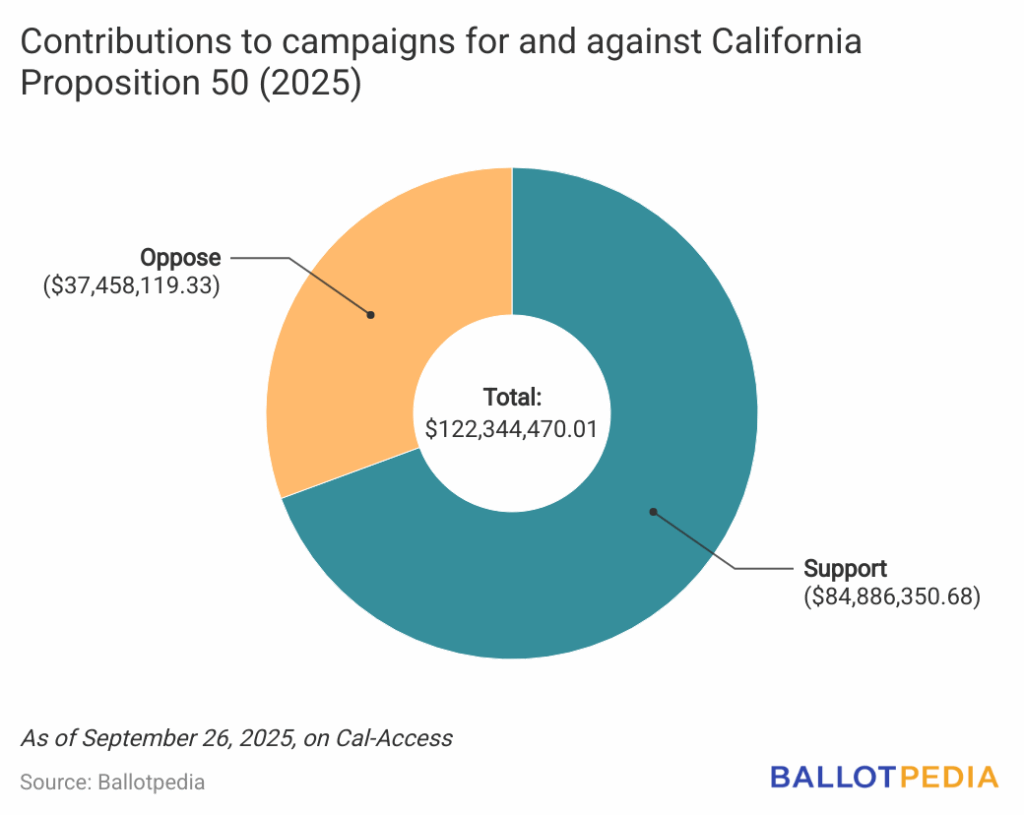
On Sept. 25, campaigns filed their first regular pre-election reports since Proposition 50 was certified for the ballot on Aug. 21. These reports covered the period between July 1 and Sept. 20. Notably, while contributions of $1,000 or more must be disclosed within 48 hours, the Sept. 25 reports provide the first look at contributions of less than $1,000.
- The support campaign reported 146,478 donations from 68,215 unique donors, 51.2% of whom live in California. The average contribution is $979. The median contribution is $100.
- The opposition campaign reported 169 donations from 135 unique donors, 88.9% of whom live in California. The average contribution is $261,588. The median contribution is $105.
As of Sept. 26, the top five donors to the support campaign were:
- The Fund for Policy Reform (FPR) contributed $10 million. FPR is a 501(c)(4) associated with the Open Society Foundations, founded by George Soros. According to FPR’s Form 990, the organization’s mission is to support legislation that “assures greater fairness in political, legal and economic systems and safeguards fundamental rights.”
- The House Majority PAC (HMP), along with the HMP for Prop 50 PAC, contributed $7.6 million. HMP is a super PAC that focuses on electing Democrats to the U.S. House of Representatives.
- The California Teachers Association (CTA) Issues PAC contributed $3 million. CTA is a teachers’ union affiliated with the National Education Association.
- The California Democratic Party made $2.9 million of in-kind contributions, such as phone banking, advertising, polling, printing, and other services.
- The California Nurses Association (CNA) contributed $2.6 million. CNA is a labor union for registered nurses.
As of Sept. 26, the top five donors to the opposition campaign were:
- Charles T. Munger, Jr. contributed $30.1 million. Munger is a physicist and political donor. He also chaired the Santa Clara County Republican Party and the California Republican Party’s Initiatives Committee.
- The Congressional Leadership Fund (CLF) contributed $5 million. The CLF is a super PAC that focuses on electing Republicans to the U.S. House.
- The Kevin McCarthy for Congress PAC contributed $1 million. McCarthy was Speaker of the U.S. House from January 2023 to October 2023.
- Thomas M. Siebel, founder and chairman of C3.ai, Inc., contributed $1 million.
- Susan Groff, who co-owns Northwest Excavating, contributed $50,000.
Among the 10 most expensive ballot measures, the side that raised the most money won nine out of 10 times. The exception occurred in 2024, when competing sports betting initiatives resulted in each campaign supporting one measure while opposing the other.
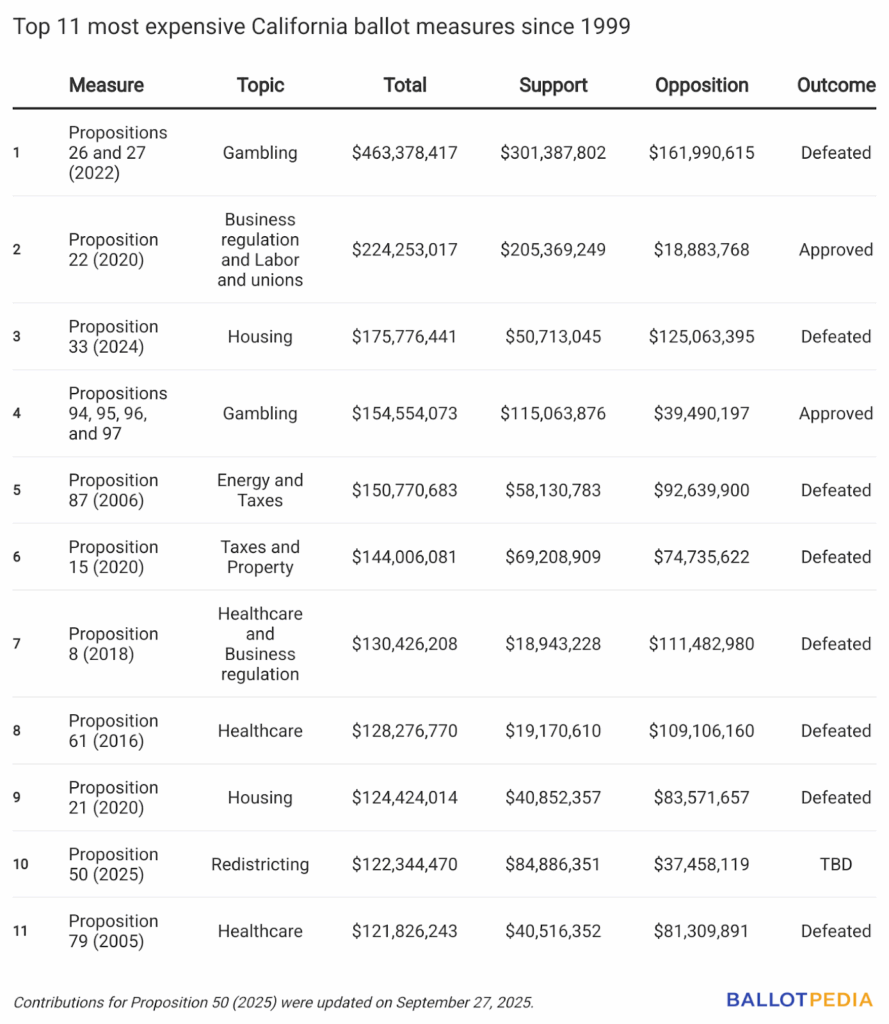
The next regular pre-election campaign finance reports are due on Oct. 31. The special election is Nov. 4.
Click here to read more about Proposition 50 and here for more about the most expensive ballot measures in California.
Seven candidates are running in the general election for Albuquerque mayor on Nov. 4
Seven candidates are running in the nonpartisan Nov. 4 mayoral election in Albuquerque, New Mexico, including the following noteworthy candidates: Incumbent Tim Keller, Mayling Armijo, Daniel Chavez, Louie Sanchez, Alexander Uballez, and Darren White.
If no candidate receives a majority, the top two finishers will advance to a runoff on Dec. 9. Albuquerque Journal‘s Justin Garcia wrote, “This is not the most crowded election in recent memory. That distinction belongs to Keller’s first race in 2017, when eight candidates ran for the position. […] With so many candidates in the race, a runoff is possible.”
KOAT’s Brian Sanderoff said, “This race will come down to a referendum on the mayor. Will people think it’s time for a change, or will people think that the mayor has progressed enough that it’s worth giving him a third [term]?” The challengers are positioning themselves against Keller on issues like homelessness and crime.
Keller, who was first elected mayor in 2017, is running on his record. According to his campaign website, “Tim Keller is running for reelection for two clear reasons. First, he’s done the real work to repair decades-long challenges holding our city back. […] Second, he’s running to stand up to Trump’s policies and the harmful cuts that threaten our families and safety.” Keller is affiliated with the Democratic Party.
Armijo is a U.S. Navy veteran and executive director of a small business development company. She was Sandoval County deputy manager and Bernalillo County director of economic development. Armijo said, “My vision for Albuquerque is grounded in safer neighborhoods, stronger small businesses, and a city government that actually delivers for the people who live here.” Armijo is affiliated with the Democratic Party.
Chavez is the president of Parking Company of America, a business that oversees many Albuquerque parking lots. His campaign website states, “As a local business owner, I’ve seen how strong businesses build strong communities — and how fast that can fall apart without real leadership. […] As Mayor, I’ll do what it takes to turn a bleak future into a better one — for all of us.” Chavez’ party affiliation has not been reported.
Sanchez is a city councilor, business owner, and retired police officer. His campaign website describes his vision as “Focused on Safer Communities, a Stronger Economy, and Real Homelessness Solutions—with a commitment to bold, collaborative leadership that delivers results.” Sanchez is affiliated with the Democratic Party.
Uballez served as a U.S. attorney during President Joe Biden’s (D) administration. He resigned at President Donald Trump’s (R) request in February 2025. Uballez said, “While we are making the streets safe, we need to get out of the way of development so that people and [small] businesses, entertainment venues, restaurants, bars and affordable housing for people to live near all of those things can exist here in Albuquerque so we can keep people here, so we can draw people here.” Uballez is affiliated with the Democratic Party.
White was head of the New Mexico State Police and sheriff of Bernalillo County. On his campaign website, White said, “I have a proven record of fighting crime, protecting our communities, and upholding law and order. I’ll unshackle the police, end Mayor Keller’s failed sanctuary policies, clean up homeless encampments, and restore safety to Albuquerque’s streets, parks, and businesses while cutting government waste and making our city a place where families and businesses can thrive again.” White has called himself a fiscal conservative
Eddie Varela is also running.
Twenty-seven of the 100 largest U.S. cities, including Albuquerque, will hold mayoral elections this year. So far, general elections have taken place in seven cities, with two elections—in Omaha, Nebraska, and Garland, Texas—resulting in a partisan change.
At the start of 2025, the mayors of 65 of the country’s 100 largest cities were Democrats, 25 were Republicans, one was a Libertarian, two were independents, and four were nonpartisan. Three mayors’ partisan affiliations were unknown.
To read more about the Albuquerque mayoral election, click here. If you’re an Albuquerque voter, check out our Sample Ballot Lookup here to prepare for Election Day.
On this date in 1889, Washington voters decided which city should be the state capital
On this date in 1889, Washington voters decided on a ballot measure to determine the location of the state capital. Since selecting a capital required a majority vote, not a plurality vote, a runoff election happened between the top three locations in 1890.
Olympia became the capital of the Territory of Washington in 1853. However, when Washington began the statehood process, voters needed to decide on a state capital.
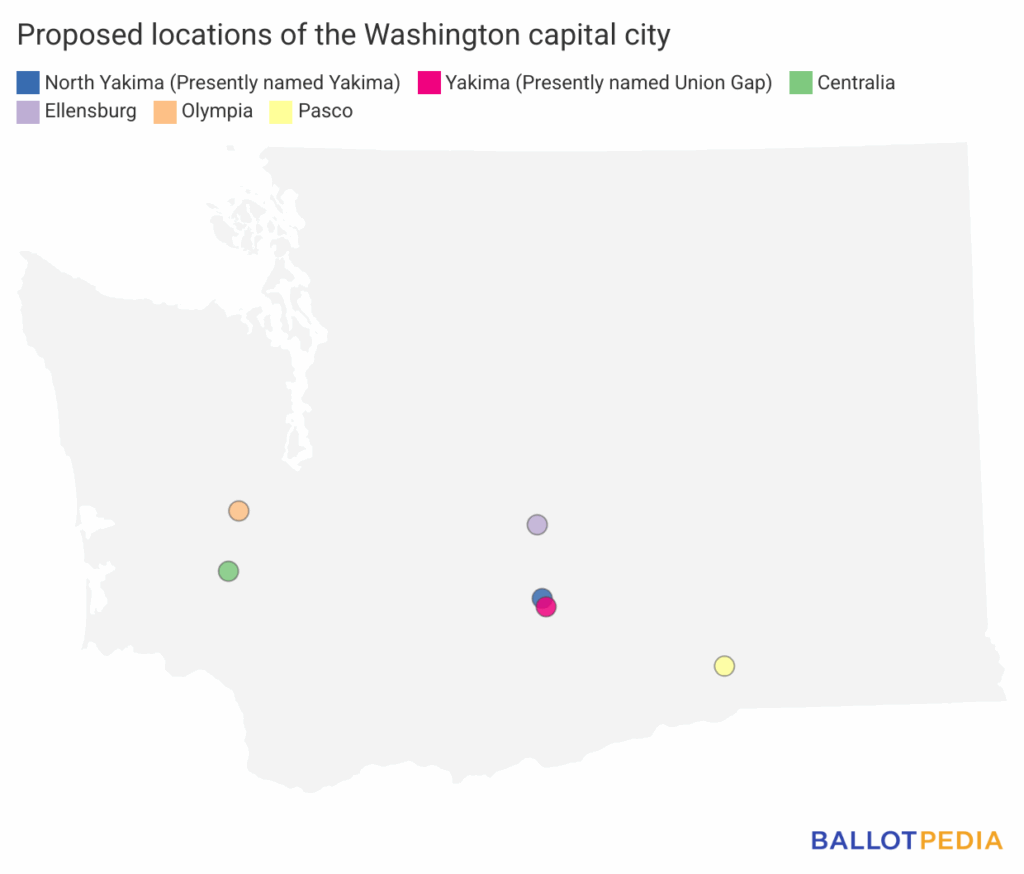
In an 1889 article, The Sunday Ledger Tacoma stated that only three cities were truly in the running for the state capital: North Yakima (today called ‘Yakima‘), Olympia, and Ellensburg. Ellensburg, presently spelled without an ‘h’ at the end, was spelled differently at the time of the election.
Debates over the state capital’s location centered on whether geographical centrality or commercial activity should carry more weight.
In the 1889 election, voters wrote in their preferred locations. Olympia, North Yakima, and Ellensburg advanced as the top three choices for the capital.
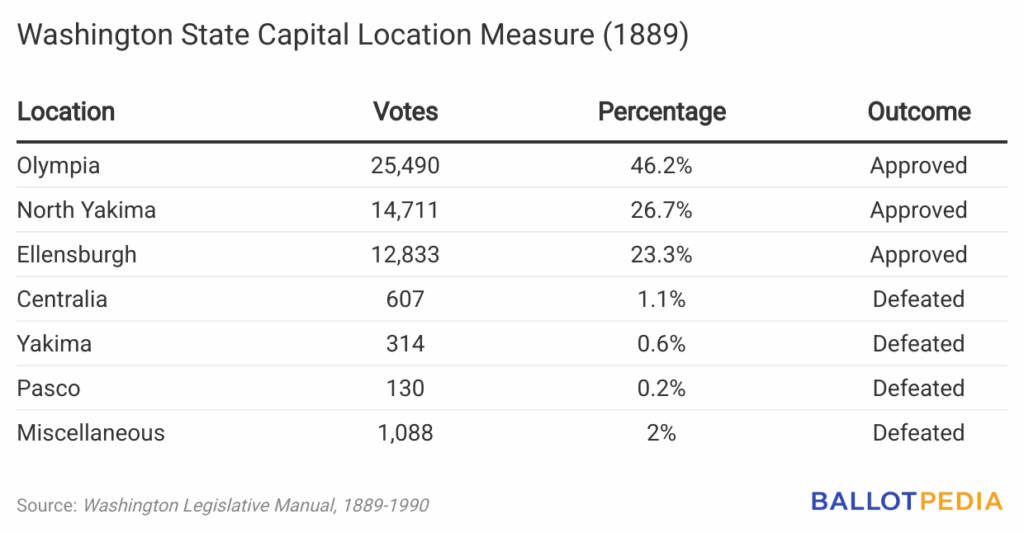
In the 1890 runoff election, Olympia won 72.7% of the vote.
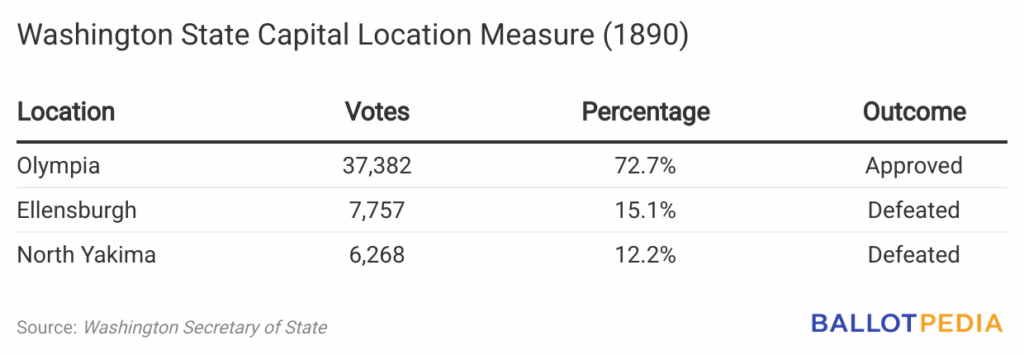
Our coverage of this measure is part of our Historic Ballot Measures project (HBM), which will document nearly 200 years of direct democracy in the U.S. This ongoing research effort will provide an unparalleled resource for researchers, reporters, and the voting public on how ballot measures have evolved, the issues they’ve covered, and the role they have played in our civic life.
Click here for more information about the 1889 measure, and here for more on the 1890 measure. Also, click here for our Historical Ballot Measure Factbook for Washington, which provides a comprehensive look at 135 years of ballot measures in the state.

